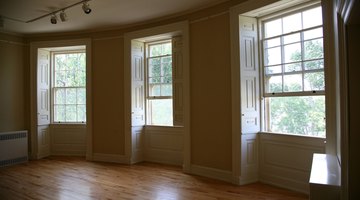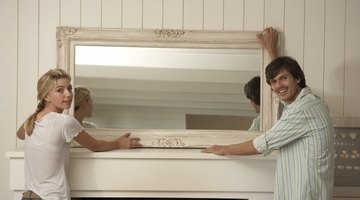How to Make a West Facing Room Brighter
A west facing room only receives light in the latter part of the day, making it significantly darker for the majority of the day than an east or south facing room. Unfortunately, short of moving house, there is nothing that can be done about the direction a room faces.

There are, however, plenty of quick and easy tricks to bounce light around the room and make a west facing room seem lighter, even when the sun is on the other side of the house.
-
Paint the walls in neutral tones, with either cool undertones for a more spacious feel, or warm undertones for a cozier atmosphere. Cool colors visually recede, which makes them appear further away than they really are, thus creating a sense of space. However, neutral colors with cool undertones will make a west facing room with little light in the mornings feel cold. Warm colors advance a room, making it feel smaller and more intimate. Using a neutral color with warmer undertones won't advance a room too much, but it will simply give a feeling of warmth to the room. Avoid dark colors as these will not reflect light in the same way as light colors.
-
Use polished wood flooring for maximum light reflection. Light colored carpets will help to lift a room, but will absorb the light rather than reflecting it. To really brighten a room, you need lots of reflective surfaces to bounce the light all around. Soften the look with a few well-placed floor rugs. This is also an opportunity to introduce splashes of warm color, and add interest to the neutral walls.
-
Stick with light colored furniture. Paint wooden furniture with white gloss paint, because glossy surfaces reflect the light. A glass-topped coffee table allows the eye to travel through the item, rather than coming to a stop, and glass is also very reflective. Avoid tall, large, heavy-looking items of furniture, and don't position anything too close to the windows. Keep the window area clear, to take maximum advantage of the light.
-
Hang mirrors on the wall opposite the windows. This way, the light from the windows bounces off the mirror and is reflected back into the room. Gather several mirrors in different sizes and shapes to create a display on the wall, similarly to how you would use pictures. On a separate wall, hang one large mirror to keep the light traveling. Frame pictures in glass frames rather than using canvas artwork, and select accessories made from glass or with highly polished finishes.




Tip
Mirror tiles make an attractive addition to the room and can be used to create focal points around the room. Glass bricks can be used to encourage light to flow into the room from other, lighter rooms, and the same effect can be achieved with glass doors rather than solid wood.
Resources
Tips
- Mirror tiles make an attractive addition to the room and can be used to create focal points around the room.
- Glass bricks can be used to encourage light to flow into the room from other, lighter rooms, and the same effect can be achieved with glass doors rather than solid wood.
Writer Bio
Based in England, Tami Mason writes for Local.com and various other websites. Mason has worked as a proofreader and copy editor since 2007 and is a trained interior designer who also specializes in art history, art and crafts.
Photo Credits
- Jupiterimages/Photos.com/Getty Images
- Jupiterimages/Photos.com/Getty Images
- Jupiterimages/Photos.com/Getty Images
- Ableimages/Photodisc/Getty Images
- Stockbyte/Stockbyte/Getty Images
- Pixland/Pixland/Getty Images
More Articles



